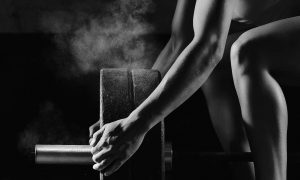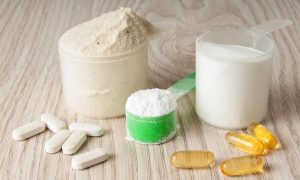Your Definitive Guide to Leg Day Training

|
|
As the more seasoned and hardcore lifters amongst you will know, leg training is extremely tough. You may think that bench pressing 315 pounds, while super-setting with cable crossovers is tough, but until you truly destroy your legs on leg day, you’ll never quite know what true hardcore training is. We all know that true friends don’t let friends skip leg day, and if you regularly train your legs, then first off, give yourself a pat on the back. No, seriously, because many bodybuilders out there, even those with fantastic physiques, don’t always train their legs regularly, and if they do, they tend not to attack them as ferociously in the gym as they do other muscle groups.
Why do people skip leg day?

Well, actually, research has found that there are two main reasons for this. The first reason is simply due to the fact that a lot of bodybuilders don’t prioritize their legs because they never have their legs on show, or if they do, then it is on a very special occasion. As their legs are always covered up, they tend not to see the point in training them especially hard. Sure, they’ll throw some leg curls and lunges in there now and then, and they may even do a few squats if they feel especially brave, but generally, they don’t see the point. The second reason is simply due to the fact that leg training is so brutal. There is however, nothing worse than a huge upper-body and a set of scrawny chicken legs, which is why training legs is just as important as training chest or biceps. If you’re looking for ways of bringing your legs up to par, this handy guide is ideal.
General leg training tips
To get the ball rolling, as it were, we’ll begin by taking a look at a few general leg training tips. Remember, your legs are equally as important as any other muscle group in your body. In fact, some might argue that they’re even more so because the muscle groups are so large, and because we rely on our legs for so much. Whatever your thoughts on leg training may be, it’s important to ensure that you’re training your legs correctly. That’s where we enter the fray. To ensure you don’t end up with spaghetti legs, we’re here to share some handy leg training tips with you, to help you build a set of wheels that Tom Platz himself would be envious of. So, without any further ado, let’s take a look at some general leg training tips:
Never go easy on leg day
Leg training is tough, and if you don’t find it tough, it’s because you aren’t training hard enough. Remember, the aim of training your legs is to cause them to grow, just like any other muscle in the body. That means that they need to be trained hard and really pushed to their limit if you wish to stimulate new growth. After training legs, you should struggle to walk within the first hour, and afterwards you should really feel pretty severe leg DOMS for the next 48 hours. That right there, is a sign of good leg training. When you train your legs, make every rep count. Train to failure, execute perfect form, switch things up if necessary, and keep the intensity nice and high.
Unless medically exempt, don’t ignore squats
When people think of leg day, squats are the first exercise that spring to mind. Squats are synonymous with leg day, and they’re synonymous for a reason – because they work! Squats are a fantastic compound exercise as they work pretty much every muscle group in the legs that you could imagine. In particular, they target the quadriceps, the hamstrings, and your glutes (remember, squats build that booty). For that reason, you should make sure that you incorporate squats into your leg training routine, in some way or another. You don’t need to be squatting every single session, and you don’t even need to base your entire workout around squats, but unless you are medically exempt, you should make sure your leg training contains some variation of a squat. Despite what people may tell you, a leg press machine will never replace a squat. Sure, leg pressing is great, and hugely effective, but alas, it’s not a suitable replacement for a squat.
Practice perfect form every single time
When you train other body parts, you can get away with being, shall we say, a little more relaxed when it comes to your form and technique. When curling for example, when you reach the last few reps of the set you’re doing, if you do need to lean back slightly, or rock back and forth to gain momentum, you can do so without causing too many issues. With leg training however, form is absolutely critical, so it should either be perfect, or nothing at all. If you are squatting and your knees aren’t AT LEAST parallel, then you aren’t going deep enough so strip a bit of weight from the bar and squat deeper. Focus on using your leg muscles to perform every single rep, and resist the temptation to adjust your positioning to help you gain momentum. To work your legs, you really need to isolate your lower-body muscles, so focus on nailing your form absolutely perfectly.
Train your calves
Unless you’re Erik Fankhouser, or a select other few bodybuilders in the world, your calves will probably be arguably the most underwhelming part of your entire body. Adding mass to the calves is extremely difficult, especially if genetics aren’t on your side. Because of this, it can be tempting to simply skip training your calves and to hope that they’re being trained enough with the other leg exercises you’re doing, but that is not ideal. Your calves need to be trained like any other muscle group, and as stubborn as they may be, you still need to train them hard. Don’t just throw a couple of calf raises in at the end of your leg session as an afterthought, really focus on isolating them and causing them to grow.
Things you should NEVER do on leg day

Now that we’ve shared a few tips on what you should be doing on leg day, we’ll now take a look at a few things that you should never do on leg day. Take a look at these common leg training mistakes and be sure to avoid making them yourself the next time you hit the gym:
Do not round your back when squatting
As we’ve now established, squats are arguably the most effective of all leg exercises, but they are not without their risks. Like all exercises, if you perform them incorrectly, you run the risk of seriously injuring yourself, and that’s the last thing you want. When it comes to squats, rounding your back is the last thing you should be doing, yet a lot of people out there actually make this mistake without even realizing. Rounding your back can potentially leave you very seriously injured, but what can you do to avoid it? Well, experts recommend that you neutrally align your spine. By rounding your back, more pressure will be placed on the discs in your back, and this is where the potential for a very serious injury can arise.
Try to keep your feet firmly planted
Many leg exercises, especially free-weight leg exercises like lunges, are known as closed-chain movements as they require the feet to be firmly fixed against a solid surface, I.E the floor. On the flipside, if you perform an exercise like say, a leg curl, your feet are actually floating, and these are known as open chain movements. During closed-chain movements, it’s absolutely vital that you keep your feet planted firmly on the floor, without moving them at all if you can help it. The reason for this is that by moving your feet, even slightly, you are putting more pressure on your knees and the more pressure the knees absorb, the more likely you will be to suffer a knee injury. In open-chain movements, moving your feet and legs slightly can be beneficial, as it can allow you to target different parts of the leg. With closed-chain movements however, make sure you have your foot position absolutely perfect before you begin the exercise, to help ensure that your knees are well protected during the course of the lift.
Don’t lift your heels on the leg press or hack squat
As you probably know, leg press machines and hack squat machines are both very popular leg machines in gyms worldwide, yet they too can be dangerous if used incorrectly. When using either machine, foot position is crucial, particularly the heel. If you observe the average gym-goer using these machines, you’ll often see their heels lifting off of the platform as they perform the exercise. Now, sometimes they do this during the negative portion of the movement because they don’t quite possess enough range of motion in their legs, or they’ll do so because they didn’t have their feet positioned correctly in the first place. Lifting the heels results in you having far less support and control during the lift, plus again, it means more strain is placed on the knees, which is the last thing you want. Put simply, get your foot position right before you begin, and be sure to not lift your heels off of the platform as you perform each rep.
Don’t try working through knee pain
Knee injuries are no joke, especially as you grow older. If you find yourself suffering from knee pain, or even slight discomfort, do not take any chances and don’t try working through the pain. It will be frustrating having to skip leg day, especially if you’ve been making progress over the weeks, but if you try training through knee pain, or a minor knee injury, doing so will only make matters worse and could result in you suffering with a serious injury that could require surgery and a very lengthy recovery period. If you experience any pain or discomfort in the knees, or anywhere else for that matter, don’t try working through the injury as it will almost certainly exasperate the problem.
How to recover from leg day

Finally, we’ll finish up by looking at what you can do to recover after a brutal leg session. Leg DOMS are awful, and when we say awful, we mean it. After a brutal leg session, puking in the gym is fairly common, as is not being able to walk up and downstairs for at least two days. Thankfully, there are things you can do to maximize your post-leg workout recovery rates. These include:
Hydrate
After training, your muscles will often cramp up and ache due to lactic acid. Lactic acid, and other toxins, can actually be flushed from your body in the form of sweat and urine, so make sure you drink plenty of water after training your legs.
Drink a protein shake
Like any other muscle group, your leg muscles require protein to stimulate the recovery process. Without protein, your muscles won’t grow or repair themselves adequately enough, and you’ll find yourself experiencing pain for longer as the muscles will take far longer to repair.
Supplement with turmeric
Turmeric is an anti-inflammatory and is one of the best natural supplements on the market for dealing with inflammation. Inflammation in the legs is often intensified after training legs, but by supplementing with turmeric you can help reduce rates of inflammation, and thereby reduce the amounts of pain you experience.
Gently stretch after training
After training any body part, really you should try to stretch, but with your legs, you really need to make an effort. Perform gentle stretching exercises and perhaps consider investing in a foam roller to help break down tough muscle knots and scar tissue in, and around the legs that would be more sore and sensitive after working your legs.














